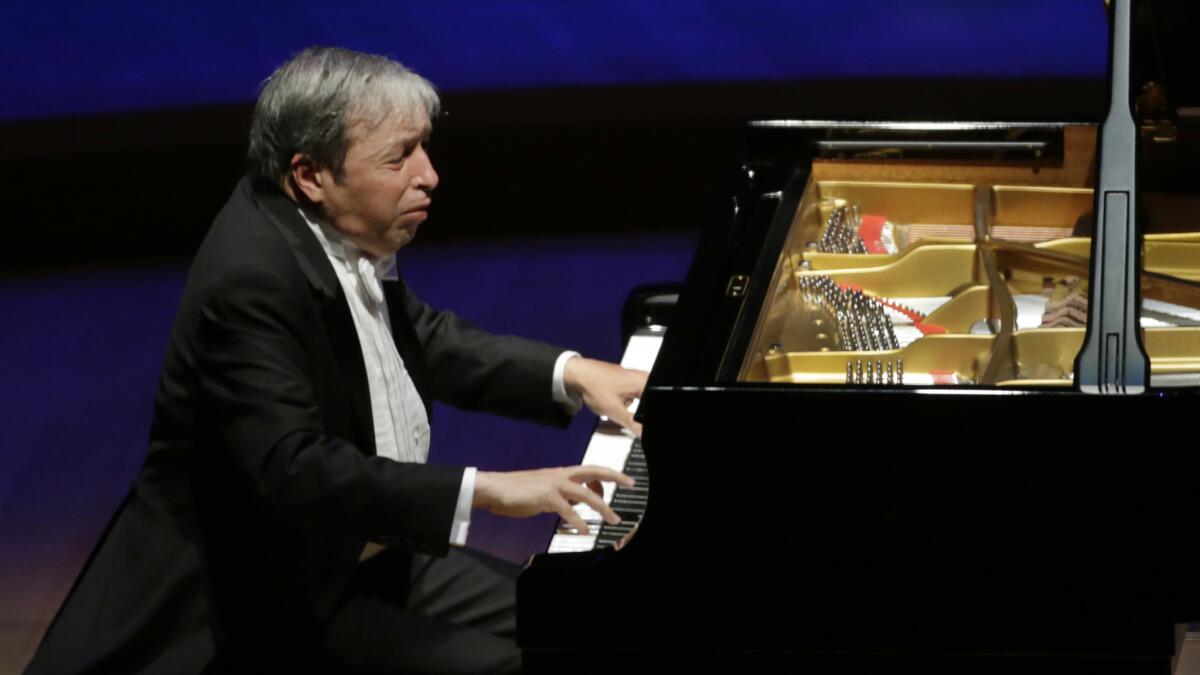Review: Pianist Murray Perahia scales the Everest of Beethoven’s ‘Hammerklavier’ in a momentous performance

Murray Perahia piano recital at Walt Disney Concert Hall in Los Angeles.
Beethoven’s massive, daunting, imposing, terrifying, exhilarating, breathtaking “Hammerklavier” Sonata is not Everest. It just seems that way as one compiles a list of roaring adjectives capable of rising sky high. Still, Beethoven’s towering sonata is often treated that way, the mountain to be conquered by alpha-male and alpha-female pianists with the bravura techniques and stamina able to thread through one of the literature’s most physically demanding and dramatic sonatas.
Were the “Hammerklavier” to be an Everest, it would have to be an intellectual Everest and a poetic one. For all the unreasonable technical demands Beethoven makes, he ultimately requires the pianist to get beyond superhuman technical issues, putting full attention on mastering profound structural issues and conveying profound depths of feeling.
Yet, in one of the most outrageous sucker punches in all music, the composer all but makes that impossible by forcing the performer to throw all caution to the wind by opening the sonata with a nerve-rackingly left-hand jump at an insanely fast metronome marking. Thinking about anything else but flying fingers under the influence of this kind of adrenaline rush is equivalent to reciting a Shakespeare sonnet and playing mental chess while simultaneously counting the precise number of seconds to pull the ripcord while skydiving.
Murray Perahia did all the above Tuesday in a momentous performance of the “Hammerklavier,” one of the great nights at Walt Disney Concert Hall. It will be Yuja Wang’s turn Monday in Santa Barbara, where she plays the sonata at the Granada Theatre and repeats it the next night at Soka University in Aliso Viejo.
The meticulously thoughtful and eloquent Perahia and the young firebrand Wang are radically different pianists, but they have one thing in common when it comes to this great challenge. Both are taking up this work unexpectedly. For Wang, who is thus far known for her huge charisma in flashier repertory, the “Hammerklavier” will be an unprecedented test of her interpretive capacities in a work that has defeated even such brilliant pianistic minds as Glenn Gould.
For Perahia, the “Hammerklavier” might have seemed a test of temperament and, possibly, physicality when he first said a decade ago that he planned to perform it. The pianist had undergone 15 difficult years of thumb problems that often forced him to play through terrible pain.
There was also the issue of temperament, Perahia, who turned 69 last week, being a famed exalted master of exquisite detail. A ritualistically formal pianist, he produces a tone of unflappable beauty that seeks the reverberant essence of each note, just as a Japanese priest officiating at a tea ceremony finds in every sip the all-consuming spirit of tea.
In the first half of the recital, Perahia conveyed a sense of pianistic perfection to a series of small pieces by Haydn, Mozart and Brahms. A trill in Haydn’s Variations in F Minor, a rush of a scale in Mozart’s Piano Sonata No. 8 in A minor, a delicately balanced viscous harmony in a ballade, a capriccio and three intermezzi from Brahms Opp. 118 and 119 series became microcosmic expressions of the full pieces. Yet every work was put together with the care of a watchmaker, one bar inexorably leading to the next.
The “Hammerklavier,” however, will have none of that. Beethoven was, indeed, the watchmaker. The four-movement score contains magnificently complex inner workings. But the merciless tempos allow no time for appreciation of details, not even in the emotionally penetrating slow movement, the most despairing in Beethoven. The exceptionally complex fugal Finale, the light at the end of a disorienting yet exhilarating tunnel that might have been designed by Frank Gehry, remains at Beethovenian tempos a step ahead of most of us.
Perahia threw himself into everything with a ferocious concentration. The opening left-hand leap to the fugue’s landing on a triumphant final cadence 40 minutes later felt like a single gesture, a life passing by during a fall and safe landing off a cliff.
The epic Adagio was exceptional. Beethoven is in a black mood. The twisted harmonies and endless melodic lines keep shifting, trying to go one way and then the next, never finding resolution or solace. For Perahia this was inescapable pain, but not to be dwelt upon. His ability to find the life in each note proved intensely moving.
In the preceding short Scherzo, Perahia came up a little short on humor. But his most brilliant coup was to make the intricate fugue at the end playful. He was very fast, as Beethoven wanted yet few pianists manage, not just for technical reasons but also because the convoluted counterpoint can easily become chaotic.
Perahia treated that chaos first as entertainment, next as joyfulness and finally as a kind of spirituality, the universe operating at its elaborate business. He became increasingly, and for him unusually, animated.
He left the stage looking completely drained, this pianist who always puts the music first having not just played a sonata but lived through a momentous human experience, a pianist who had, himself, drained the bottomless “Hammerklavier.”
MORE:
Los Angeles Philharmonic pays tribute to its late new-music mentor Steven Stucky
Kanye meets Beethoven: How young musicians are mixing classical with pop
Hear Now Music Festival reveals the essence of Los Angeles new music -- we do as we please
More to Read
The biggest entertainment stories
Get our big stories about Hollywood, film, television, music, arts, culture and more right in your inbox as soon as they publish.
You may occasionally receive promotional content from the Los Angeles Times.







